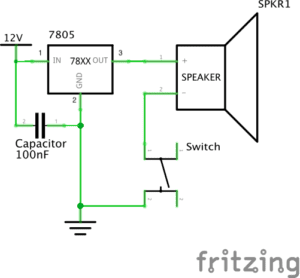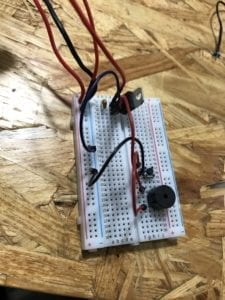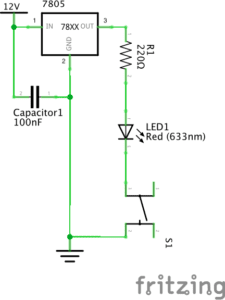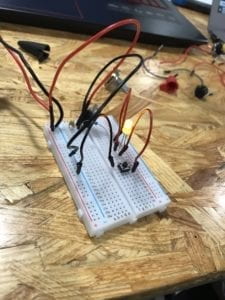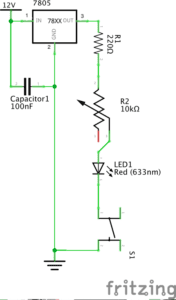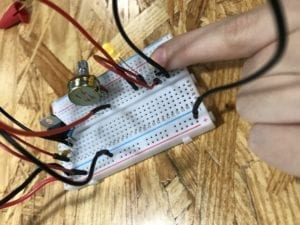Circuit 1: Door Bell

Parts:
- Breadboard: Provides a base for the connections in a circuit
- LM7805 Voltage regulator: Controls voltage, allowing for consistent output
- Switch: When pressed, connects the circuit to allow power to reach the speaker
- Speaker: Vibrates, creating a sound, with the introduction of electric current
- Jumper cables: Provide connections for the circuit
- Barrel jack: Connects power supply to outlet
- 100 nF (0.1uF) Capacitor: Stores (and helps regulate) electric energy
- 12 Volt Power Supply: Provides power source
Process:
- While this was the simplest circuit, we had to acclimate to using the components and building circuits. The biggest challenge for us in this aspect was figuring out the difference between the power and the ground, especially when connecting the voltage regulator. Finishing the circuit also provided some difficulty, as we were initially unsure of how power was flowing to the ground from the buzzer and switch. Moving on in the class, I know that I will have to put more effort into distinguishing which wires should be ground. Despite this confusion, we finished this circuit fairly quickly after getting used to the components.
Circuit 2: Lamp

Parts:
- 220 ohm Resistor: Reduces current flow
- LED: Emits light with electric current
- Multimeter: Used to measure resistance
Process:
- The most difficult process in this circuit was learning to measure the resistor with the multimeter. Since our fingers effect the reading of the multimeter, we asked for advice and found that measuring the resistor in between our fingers gave an accurate reading. After finding the correct resistor we simply made small adjustments to our previous circuit in order to add the LED and the resistor.
Circuit 3: Dimmable Lamp

Parts:
- 10K ohm Variable Resistor (Potentiometer): Allows for interaction, with a turn of the dial adjusting the strength of the electric current
Process:
- This circuit was the easiest of the three. After adjusting the position of the light, we simply added the variable resistor. I did feel that I learned something from observing the interactivity of the resistor — this technology is basic yet I had never put thought into how it works. For that reason, this circuit was the most interesting to us.
Push-Button Switch
Process:
- After finishing circuit 3, my partner and I disassembled our circuit. For this reason, we had to reassemble the circuit for the inclusion of the new button. We had some difficulty with this new circuit. Again, we found ourselves confused with the difference between ground and power. We also found ourselves debating ways in which we could cut down on the number of jumper cables, simplifying our circuit. Although we had some difficulty we did eventually create a new circuit and I found the process useful in practicing the building process.
Question One
The interactivity reading introduced the idea that interactivity comes on a spectrum. This felt very clear to me thinking on the different circuits we built in recitation. The third circuit, which included a dimmable light, felt more interactive than those which had only a switch. Although all required action from a human (the press of the switch) to operate, this circuit was more responsive, giving not only the option of on/off but also the ability to control how much light was emitted.
Question Two
As someone who is very interested in music, there are many interesting interactive possibilities. One idea that I have seen in an exhibit in my hometown in Ohio is an orchestra made of “electric instruments” — one example being a harp which sensed the movement of a human finger in a certain place and played the correct tone in response. I think this idea could be developed to help disabled musicians, similar to the EyeWriter being used to allow a disabled graffiti artist do his work. These examples which combine human creativity and electronic tools are especially interesting to me.
